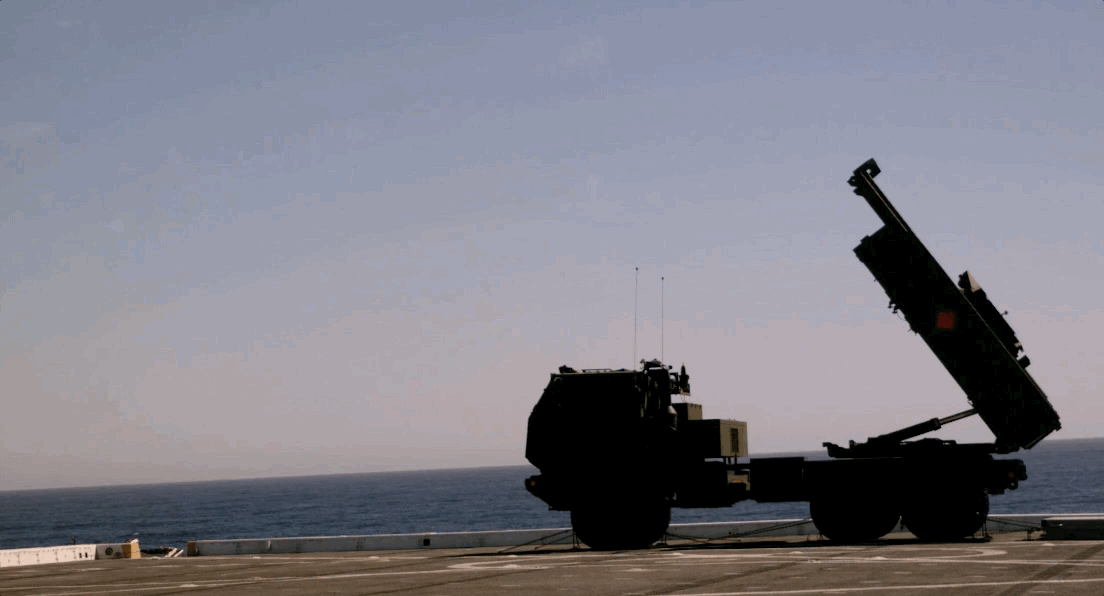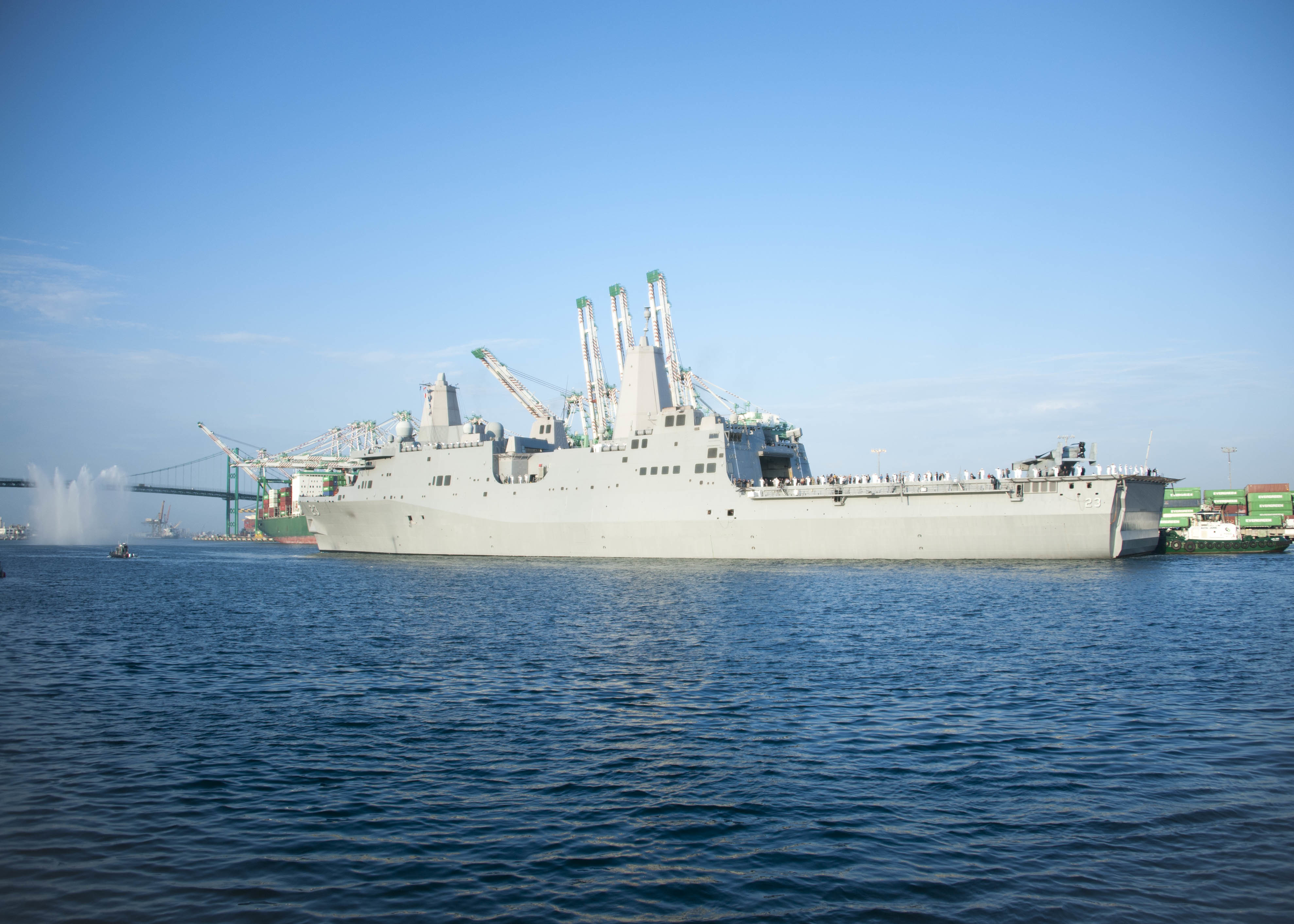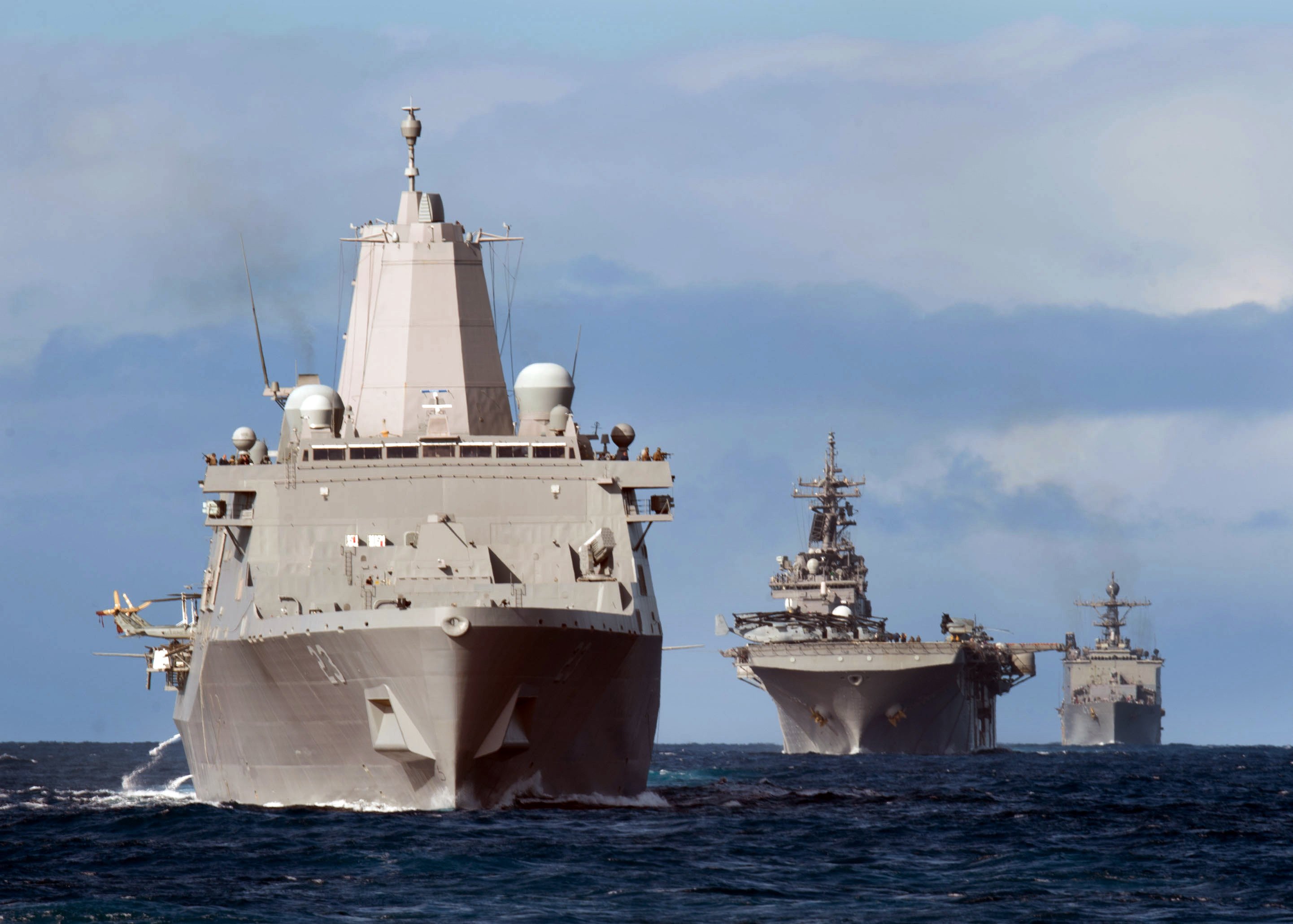
ABOARD THE AMPHIBIOUS ASSAULT SHIP USS ESSEX – The daytime launch of the High Mobility Artillery Rocket System on Sunday might have seemed like another training mission if the Marines hadn’t fired it from an amphibious ship operating at sea.
A detachment of Marines with Camp Pendleton, Calif.-based 5th Battalion, 11th Marines, set up the vehicle-borne launch system on the flight deck of amphibious transport dock USS Anchorage (LPD-23). Programmed with information about the objective – suspected enemy air defenses – on a nearby island, the HIMARS launcher fired off a rocket at a target 70 kilometers away.
Target destroyed, officials said.
The missile strike, coming during the biannual amphibious task force exercise Dawn Blitz off southern California, marked a big first for the Navy and the Marine Corps.
“The ability to project power from and at sea is critical,” Lt. Col. Tom Savage, operations officer with 1st Marine Expeditionary Brigade, told a small group of journalists at a briefing aboard USS Essex, the flagship for the exercise.
“It’s a significant capability.”
Senior officials have been looking at how the Marine Corps, which is historically focused on land based operations, can support the Navy at sea and bolster the amphibious force’s ability to obtain and maintain “sea control,” in areas of current and potential future operations.
Just in the past year, Gen. Robert Neller, commandant of the Marine Corps, several times has spoken about using HIMARS to launch various munitions against targets at sea and ashore. At the Modern Marine Expo in Quantico, Va., last month, Defense News reported, Neller said “you’re going to see precision fire delivered off amphib ships, whether it comes out of tube guns or rockets or delivered from unmanned systems.”
HIMARS, a vehicle-launched rocket system first developed for the Army, is a land-based precision weapons system the Marine Corps uses for fire support against artillery, armor and air defenses. Its GPS-guided munitions travel well beyond the reach of its field artillery cannons. It’s transportable by C-130 Hercules aircraft. Each crew has a launcher, resupply vehicle and two resupply trailers, mobility that allows crews to quickly set up, fire and relocate.
The sea-based experiment during Dawn Blitz, which runs Oct. 20 to 29 with I Marine Expeditionary Force and 3rd Fleet forces, marked the first time the self-contained, vehicle-launched rocket system has been fired from an amphibious ship.
HIMARS “is very precise, which will minimize civilian casualties. It helps hit that target you want to hit and nothing else,” said Rear Adm. Cathal O’Connor, ESG-3’s commander.
Officials have wondered: What would happen – when deploying Marines bring it aboard ship – if we fired it at sea?
Unlike the steady base on land, a ship at sea “is a launch platform that is basically moving in four dimensions – time, pitch, roll, yaw,” said O’Connor, a veteran surface warfare officer, said in a media roundtable aboard Essex.
That could fray the nerves of any fire control team. So they worked with contractors to rework targeting software to hit targets at the Navy’s bombing ranges at San Clemente Island while underway. “We can be at sea and we have a mobile, maneuvering platform – hard to target – and now we are able to hit a fixed target ashore,” he said.
O’Connor said the target “could have been a surface-to-air missile. It could have been a radar site which was monitoring the area that we were operating in. It could have been a cruise missile site. Or it could have been a command-and-control center – all of which would impact our ability to go and operate where we want to be.”
“So the ability to launch that HIMARS from the sea to strike that target now suddenly says, hey I can use this capability on this ship and we can wire it together with the different sensors already in place and be able to impact that,” he said. With it, “I don’t necessarily have to launch an F-35; I don’t necessarily have to move the destroyer off its current mission to go intercept a target. I can use this same HIMARS launcher to reach that target.
“And then when I’m done, I can leave it there. I can build a base for it. I can break it down – because it’s at an expeditionary advanced base – and I can bring it back on a hovercraft.”
And once back on ship, Marines “can refit it and do all the maintenance they need to while we sail onto the next thing,” he added. That extra role “will give the folks in D.C. and the regional combatant commanders more flexibility.”
The new capability also potentially gives the Marine Corps a piece of the sea control mission.
“Traditionally, the Navy is responsible for sea control. Once we control that, we deliver the Marines ashore,” said Cmdr. Matt Hoekstra, an operations officer with ESG-3.
“We are one of the first forces in the theater,” Hoekstra noted, and “there’s a lot more that has to come in” to support initial operations and create the environment for follow-on forces and support.

But amphibious forces, such as amphibious ready groups, have shipboard self-defense systems but limited strike capability, and they typically don’t deploy with ships such as destroyers that can strike targets at sea or further inland. “We don’t have all the fires a carrier strike group would have,” Hoekstra said. So HIMARS would “augment” naval fires and, ultimately, enable and support sea control.
On Monday, a Marine raid force boarded MV-22 Osprey tilt-rotors and CH-53E Super Stallion helicopters and flew off Essex for the mission to capture an enemy-held airfield, which for the scenario was the airfield at the north end of San Clemente Island.
After capturing the airfield, they set to secure the nearby beach so follow-on amphibious forces could arrive.
“The next stage [is], let’s send the HIMARS ashore and then it can start ranging targets at sea,” said O’Connor, the amphibious task force commander for the Dawn Blitz exercise. “Suddenly, you have a mobile capability that was at sea and is now ashore, and now you’ve got an opportunity to maneuver the ships away with this providing overwatch. It’s pretty amazing.”
That plan involved sending the HIMARS crew, along with ammunition, ashore via air-cushioned landing craft (LCAC) with the forces. Once on land, the force would be poised to respond to offensive operations or against threats, whether these are at sea, say, an enemy vessel, or further inland.
The objective “could be at sea or it could be on land,” said Brig. Gen. Rick Uribe, I MEF’s deputy commander and commander of the 1st Marine Expeditionary Brigade at Camp Pendleton. “So this gives us great flexibility to be able to go after whatever it is at the moment, whether it’s a surface target or land targets.”
“It’s all hands to the fight,” Uribe said. “On ship, we have Marines sitting below deck. They have weapons. We’ve got to think about creative ways to utilize that capability… to make sure that whatever the force is, wherever it’s going, that it’s protected and we can get to our objective area.”
So Marines who are available and aren’t tasked with other missions, such as while ships are in transit, can “help the amphibious force protect itself,” he said. “These are all concepts we are looking at.”
“That’s not too different than in World War II,” added O’Connor, noting South Pacific battles during World War II where Marines with land-based coastal defense units had anti-air and some anti-ship capabilities.

During the Battle of Wake Island in December 1941, for example, Marines firing their 5-inch guns sunk the Japanese destroyer Hayate. The heroics of that battle today are memorialized in Marine Fighter Attack Squadron 211, the F-35B Lightning II squadron nicknamed the “Wake Island Avengers” and, ironically, operating with Essex for Dawn Blitz. The squadron is slated to deploy with the Essex and the 13th Marine Expeditionary Unit later next year.
The F-35 “is a game-changer,” O’Connor said, echoing an oft-repeated description of the added capabilities the jet gives the services that don’t exist in older aircraft.
The AV-8B Harrier, he noted, was “developed for specific types of missions. It wasn’t really developed for air defense missions,” unlike the fifth-generation, multi-mission role of the F-35.”
The F-35B will give options when, say, a carrier air wing isn’t available, he said. “It has the ability to go head to head with any aircraft in the world today,” he added. With its stealthy features, it can take out coastal defenses and missile sites “which pose a problem if you’re trying to do a standard, conventional type of operation.”
As for HIMARS, both commanders relayed support to their three-star bosses. But do they want it? “Oh yeah. Look at what we just did,” O’Connor said.
“One shot, to be fair, is one shot,” Uribe added. “The shot did exactly what we wanted it to do, based on the model. So it is a basis from which to go forward.”
“And then,” said O’Connor, “there is the question of trade-offs because ships are limited in volume, weight and personnel. So in order to bring X, we’d have to give up Y. So it’s something to consider.”





